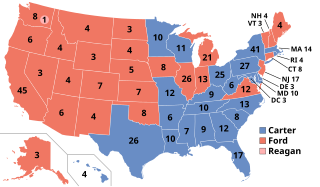
The 1976 United States presidential election was the 48th quadrennial presidential election. It was held on Tuesday, November 2, 1976. Democrat Jimmy Carter of Georgia defeated incumbent Republican President Gerald Ford from Michigan. Carter's win represented the lone Democratic victory in a presidential election held between 1968 and 1988.

The 1984 United States presidential election was the 50th quadrennial presidential election. It was held on Tuesday, November 6, 1984. Incumbent Republican President Ronald Reagan defeated former Vice President Walter Mondale, the Democratic candidate.

Walter Frederick "Fritz" Mondale is an American politician, diplomat and lawyer who served as the 42nd vice president of the United States from 1977 to 1981. A United States senator from Minnesota (1964–1976), he was the Democratic Party's nominee in the United States presidential election of 1984, but lost to Ronald Reagan in an Electoral College landslide. Reagan won 49 states while Mondale carried his home state of Minnesota and District of Columbia. He became the oldest-living former U.S. vice president after the death of George H. W. Bush in 2018.
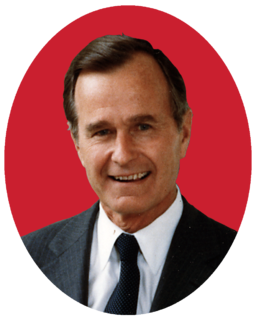
The 1988 Republican National Convention of the Republican Party of the United States was held in the Louisiana Superdome in New Orleans, Louisiana from August 15 to August 18, 1988. It was the second time that a major party held its convention in one of the five states known as the Deep South, coming on the heels of the 1988 Democratic National Convention, which was held in Atlanta, Georgia. Much of the impetus for holding the convention in the Superdome came from the Louisiana Republican National Committeewoman Virginia Martinez of New Orleans, who lobbied on behalf of her adopted home city as the convention site as a member of the RNC Executive Committee.

The 1976 Republican National Convention was a United States political convention of the Republican Party that met from August 16 to August 19, 1976, to select the party's nominee for President. Held in Kemper Arena in Kansas City, Missouri, the convention nominated President Gerald Ford for a full term, but only after narrowly defeating a strong challenge from former California Governor Ronald Reagan. The convention also nominated Senator Robert J. Dole of Kansas for Vice President, instead of Vice President Nelson Rockefeller. The keynote address was delivered by Tennessee Senator Howard Baker. Other notable speakers included Minnesota Representative Al Quie, retired Lieutenant Colonel and former Vietnam prisoner of war Raymond Schrump, former Texas Governor John Connally, Providence, Rhode Island mayor Vincent Cianci and Michigan Senator Robert P. Griffin. It is the last national convention by either of the two major parties to feature a seriously contested nomination between candidates.

Ronald Reagan, the 33rd Governor of California, announced his candidacy for President of the United States in New York City on November 13, 1979. On July 17, 1980, he became the nominee of the Republican Party for the 1980 presidential election. After receiving the Republican nomination, he selected one of his opponents in the primary elections, George H. W. Bush, to be his running mate.
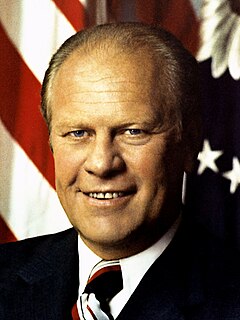
The 1976 United States presidential election in Vermont took place on November 2, 1976, as part of the 1976 United States Presidential Election which was held throughout all fifty states and the District of Columbia. Voters chose three representatives, or electors to the Electoral College, who voted for president and vice president.
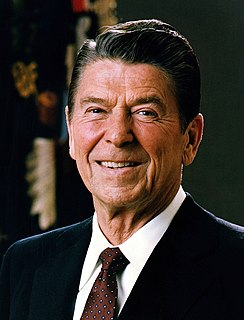
The 1980 United States presidential election in New Jersey took place on November 4, 1980. All fifty states and the District of Columbia, were part of the 1980 United States presidential election. New Jersey voters chose seventeen electors to the Electoral College, which selected the president and vice president.

The 1984 United States presidential election in Idaho took place on November 6, 1984. All 50 states and the District of Columbia, were part of the 1984 United States presidential election. Idaho voters chose 4 electors to the Electoral College, which selected the president and vice president of the United States.

The 1984 United States presidential election in South Dakota took place on November 6, 1984. All 50 states and the District of Columbia, were part of the 1984 United States presidential election. South Dakota voters chose 3 electors to the Electoral College, which selected the president and vice president of the United States.

The 1984 United States presidential election in Michigan took place on November 6, 1984. All 50 states and the District of Columbia, were part of the 1984 United States presidential election. Michigan voters chose 20 electors to the Electoral College, which selected the president and vice president of the United States.

The 1984 United States presidential election in Ohio took place on November 6, 1984. All 50 states and the District of Columbia, were part of the 1984 United States presidential election. Ohio voters chose 23 electors to the Electoral College, which selected the president and vice president of the United States.

The 1980 United States presidential election in New Hampshire took place on November 4, 1980, as part of the 1980 United States presidential election, which was held throughout all 50 states and D.C. Voters chose 4 representatives, or electors to the Electoral College, who voted for president and vice president.

This article lists those who were potential candidates for the Republican nomination for Vice President of the United States in the 1988 election. Incumbent Vice President George H.W. Bush won the 1988 Republican nomination for President of the United States, and chose Indiana Senator Dan Quayle as his running mate. The selection of Quayle surprised many of Bush's closest advisers, who had expected Bush to pick a more well-known running mate. However, Bush adviser Roger Ailes helped convince Bush that Quayle would be able to effectively attack the Democratic presidential nominee, Michael Dukakis. Bush also liked Quayle's youth and felt that Quayle would make for a loyal vice president. The Bush-Quayle ticket ultimately defeated the Dukakis-Bentsen ticket in the 1988 election.
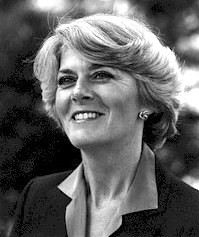
This article lists those who were potential candidates for the Democratic nomination for Vice President of the United States in the 1984 election. Former Vice President Walter Mondale won the 1984 Democratic nomination for President of the United States, and chose New York Representative Geraldine Ferraro as his running mate. Ferraro was the first woman to be a part of a national ticket for a major party. Mondale chose Ferraro in hopes of energizing the base and winning the votes of women, but also because he viewed her as a solid legislator who had won the approval of Speaker Tip O'Neill. John R. Reilly, an attorney and a senior adviser to Mondale, managed the search for a running mate. Mondale seriously considered his major rival for the 1984 presidential nomination, Senator Gary Hart, but Mondale refused to consider a second rival, Jesse Jackson, on the grounds that the differences between their policies were too great. The Mondale-Ferraro ticket ultimately lost to the Reagan-Bush ticket.

This article lists those who were potential candidates for the Democratic nomination for Vice President of the United States in the 1976 election. Former Georgia Governor Jimmy Carter won the 1976 Democratic nomination for President of the United States, and chose Minnesota Senator Walter Mondale as his running mate. According to Joel Goldstein, a legal professor and the author of several works on the vice presidency, 1976 marked the beginning of the modern vice presidential selection process, with candidates undergoing extensive vetting. Carter thought that the vice president could be an important asset for a president, and Mondale became a major part of Carter's campaign. The choice of Mondale helped Carter, a Southern "outsider" with little experience in Washington, rally the Democratic base to his candidacy. The Carter-Mondale ticket defeated the Ford-Dole ticket in the 1976 election.
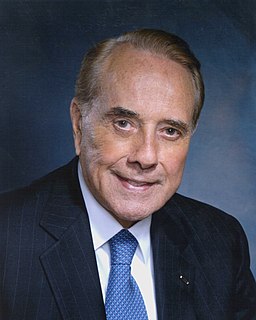
This article lists those who were potential candidates for the Republican nomination for Vice President of the United States in the 1976 election. At the 1976 Republican National Convention, incumbent President Gerald Ford narrowly won the presidential nomination over former California Governor Ronald Reagan. Ford had decided not to pick Vice President Nelson Rockefeller as his running mate, due to Rockefeller's unpopularity with the right wing of the Republican Party. Ford chose Kansas Senator Bob Dole as his running mate, instead. Dole was acceptable to the conservative wing of the party, and Ford hoped that Dole would help the ticket win the western states and the agricultural vote. The Ford-Dole ticket lost the general election to the Carter-Mondale ticket. Though he did not win the nomination, Reagan announced before the convention that he would pick Senator Richard Schweiker of Pennsylvania as his running mate.
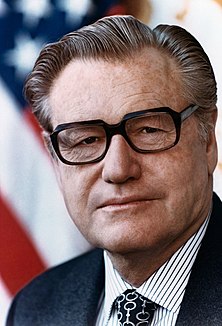
On August 9, 1974, Republican President Richard Nixon was forced to resign following the Watergate Scandal. Vice President Gerald Ford ascended to the presidency, leaving the office of vice president vacant. Under the terms of the 25th Amendment, a vice presidential vacancy is filled when the president nominates a candidate who is confirmed by both houses of Congress, which were controlled by the Democrats.
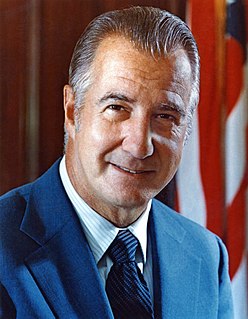
This article lists those who were potential candidates for the Republican nomination for Vice President of the United States in the 1968 election. After winning the Republican presidential nomination at the 1968 Republican National Convention, former Vice President Richard Nixon convened a series of meetings with close advisers and party leaders such as Strom Thurmond in order to choose his running mate. Nixon ultimately asked the convention to nominate Maryland Governor Spiro Agnew as his running mate. By a large margin, Agnew won the vice presidential nomination on the first ballot over Michigan Governor George W. Romney, who was supported by a faction of liberal Republicans. Nixon chose Agnew because he wanted a centrist who was broadly acceptable to the party, had experience with domestic issues, and appealed to Southern voters. The Nixon-Agnew ticket defeated the Humphrey-Muskie ticket, and also won re-election in 1972, defeating the McGovern-Shriver ticket. However, Agnew was forced to resign as Vice President in 1973 due to a controversy regarding his personal taxes.






















